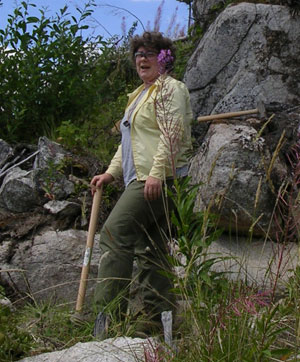Biography:
Katrin received her BSc and MSc degrees from Simon Fraser University, with the latter being a study of Eocene volcanism and tectonism in south central British Columbia. She then taught various undergraduate courses as a sessional instructor (UBC, SFU), and undertook various contracts to compile the geochronological dataset for various territorial, provincial, and federal geological surveys (YGS, BCGSB, GSC). Katrin remained active in research in the area of slab window magmatism, before beginning her PhD project at UBC in September 2005. The current project focuses on the relationship between plate boundary conditions (slab edges) at convergent margin settings and magma source, as determined from isotope and trace-element geochemistry. The project will also address outstanding issues regarding the timing and style of crustal growth of the southern Canadian Cordillera through a detailed inheritance study on magmatic zircon.
Project:
The Ph.D. project bridges the petrologic and tectonic scales of study of convergent margins at the Mesozoic Canadian Cordillera type-setting for crustal growth by accretionary tectonism. The project objectives are threefold: 1) To advance the petrologic knowledge-base of subduction zone magmatism by examining possible linkages between slab dynamic and magma source at various stages of re-establishment of subduction following collision in an accretionary setting. Specifically, it is envisioned that changes in slab dynamic at the nascent convergence, steady-state subduction, and accretion/post-collision stages of a subduction cycle and exert a strong control on available sources contributing to magmagenesis (supra-slab mantle wedge, subducted sediment, slab, sub-slab asthenosphere).
The major tool being applied is multi-system isotope (Sr, Nd, Pb, Hf, O) and high-resolution trace-element geochemistry on new sampling of Late Triassic, Early Jurassic and Middle Jurassic intrusions, southern Quesnel terrane; 2) To identify primary magmatic source(s) for the metallogenic components of porphyry-mineralized Mesozoic arc magmatism of the Quesnel terrane. A paucity of published geochemical data for these units has inhibited meaningful petrologic interpretation. The Quesnel intrusive samples are suitable for application to this and the previous objective; and 3) To test a subset of previously published tectonic hypotheses regarding the specific style and timing of assembly of inboard terranes of the southern Canadian Cordillera. Specifically, a study of the coupled-system isotope compositions (Rb-Sr, Sm-Nd, Lu-Hf, Pb-Pb, O) will be paired with an inheritance study (Hf, O, U-Pb) of magmatic zircon from granitoids between two or more crustal blocks of interest (Ancestral North America, Quesnel, Cache Creek and Stikine terranes, and the Coast Plutonic Complex). This approach has the potential to resolve ongoing debate regarding pre-collisionary affinities between the crustal blocks.
